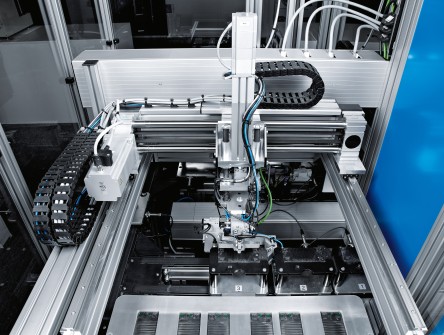效率高、排放少、无机械磨损——作为可持续能源供应者,燃料电池具有许多优势。它们适用于推进车辆、为移动设备提供动力、用作固定电站的高效执行装置等等。双极板是其关键组件。电极板由金属、塑料或碳纳米管制成,并涂有铂或钯等催化剂。它们将反应气体和冷却介质分开,并将其分配到燃料电池的各个反应区。为了保证良好的导电性、导热性和耐化学品性能以及高机械接触压力,双极板必须具有非常高的质量。P+K Maschinen- und Anlagenbau GmbH 生产的新型检测装置检查双极板的表面光洁度,并测量其厚度。Festo 的电缸 EPCO、步进电机 EMMS-ST 和电机控制器 CMMO-ST 共同确保在检测装置中实现双极板的无振动输送。作为 ZIM 合作项目的一部分,该系统由位于杜伊斯堡的 The Hydrogen and Fuel Cell Centre ZBT GmbH、柏林的应用计算机科学促进会和德国多特蒙德的 divis intelligent solutions GmbH 共同开发。
直接能源
燃料电池 170 多年前就已被发现,但它们的发展多年来一直受制于内燃机。尽管它们在 20 世纪 60 年代就作为一种零排放能源推动了登月,但其潜力是随着气候变化争论的愈演愈烈才引起了更广泛的公众关注。与热力发动机不同,燃料电池直接将化学能转化为电能。它们不需要事先进行热处理和机械加工。燃料电池没有复杂的热能和动力转换,但能达到很高的效率。单个电池由两个电极和一个半透膜(也称为双极板)组成。两个电极之间的氢氧电子和质子交换即产生电能。
另一个问题:可再生能源
Festo 专家 Michael Karcher 接受客户杂志“自动化趋势”(trends in automation) 的采访。
自动化趋势:Festo 如何支持可再生能源的发展?
Festo 工业领域 ELA 和太阳能部门负责人 Michael Karcher:自 2006 年以来,我们 Festo 人一直在研究可再生能源生产技术。我们为新技术探索工序,并开发实用的解决方案, 包括设计新型夹具和输送系统,确保它们不会破坏敏感产品的表面光洁度。
自动化趋势:这能为燃料电池领域带来哪些优势?
Michael Karcher:在燃料电池的生产中,低振动抓取系统可以增加周期次数,从而有助于提高生产效率。如果我们能降低生产成本,燃料电池等可再生能源就更容易进入市场。
非接触式输送
P+K 的创新性检测装置目前正用于科学研究和为一级供应商开发新型燃料电池生产技术。检测过程共在 12 个独立的工位上进行。电缸 EPCO 确保在这些工位之间执行低振动输送。在第一个工位,伯努利式吸盘从输送机上拿起双极板,将其放在工件托架上。为了将电极板放置在托架上,气动打开托架的一角,将双极板放置在托架上,然后通过弹簧机构气动关闭托架。
缓慢操作
接下来,使用高性能工业相机对双极板冷却侧进行目视检查, 由亮场和暗场照明提供支持。所有类型的表面缺陷都可以通过不同的照明条件识别出来。在随后的 180 度旋转工位,对下侧进行表面检测,也称流场侧。检测工位从 9 个点测定双极板的厚度。工位上方的监视器显示双极板的当前图像,用户还可查看测量数据,十分好用。通过与图像数据对比即可看出双极板的质量是否足够好。缺陷零件在加工过程中被排出,同时系统将合格零件输送到中转站。在这里,Z 轴上的电气输送装置将它们放入匣盒中。电缸 EPCO 确保将它们平稳输送到储存位置。它们的终端位置缓冲器、滚珠丝杠和非旋转滑动轴承活塞杆采用先进技术,可防止对匣盒中的双极板造成任何损伤。
连续输送
电缸 EPCO 辅助的流体运动实现系统中 16 个工件托架的连续循环。这是实现大约 4 秒的短周期时间的唯一方法。在测量工位上没有时间停下系统进行图像采集。定位任务与测量任务并行执行。使用常规气缸会产生冲击和振动,对相机的测量结果产生不利影响。平稳运行的电缸 EPCO 则可避免这个问题。这类气缸还具有示教简单、调试和产品转换成本低等优势。
IO-Link 被用作工厂范围内的总线系统,涵盖主设备到所有传感器和驱动器。这么一来,所有的系统外围设备都可以便捷连接,从而大大减少编程时间。P+K 的新型检测装置证明工序自动化组件的逐步持续开发有助于突破性技术的发展。

将双极板旋转 90 度或 180 度——此操作通过在工位 1 的三维龙门架内的 Z 轴上安装气动摆动驱动器 DRQD 实现。

阀岛 VTUG 控制系统的所有气动驱动器,通过 IO-Link 连接到主控制器。
P+K Maschinen- und Anlagenbau GmbH
Schlagbaumer Straße 92a
42653 Solingen
Germany
业务领域:机电系统、专用机械、制造设备、夹具、装配系统、检测站、泄漏检测仪的设计、开发和生产